It looks like you're using an Ad Blocker.
Please white-list or disable AboveTopSecret.com in your ad-blocking tool.
Thank you.
Some features of ATS will be disabled while you continue to use an ad-blocker.
According to Insertions/Deletions Polymorphism in Tribal Populations of Southern India and their possible Evolutionary Implications, Human Biology. Vol 75. No. 6 December 2003 by Vishwanathan, H., et al., the Toda & Kota have shared genes which separate them from the other Nilgiri Hill Tribes and share their closest affinity to the Greek Cypriots.
The Todas are a small pastoral community living on the 7,000 Nilgiri Hills in South India. They believe in 1600 or 1800 superior godlike beings, the two most important being On and Teikirzi. On is the male god of Amnodr, the realm of the dead, and he created the Todas and their buffaloes. He was himself a dairyman.
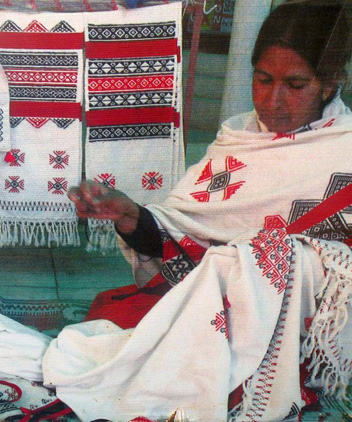
Teikirzi is a female deity and more important with the people, whom she once ruled when she lived in the Nilgiris and established Toda social and ceremonial laws. Most other deities are hill-gods, each associated with a particular hill. There are also two river-gods belonging to the two main rivers. Toda religion is based on the buffaloes and their milk. The temples are the dairies
India Tribal People
The Toda language belongs to the Dravidian family; it separated from Tamil-Malayalam circa 3rd century B.C. Todas' linguistic affiliations are with South India and even their much-remarked physical characteristics - tall, with fairish skins, aquiline noses and so on - are neither true of all Todas nor absent in the wider South Indian community
Central to Toda religion are sacred places associated with the community's dairy-temples, their related buffalo herds, appurtenances and priesthood. These are not simply places where gods reside, but are themselves divine, the "gods of the places", the Todas say. Entry into a Toda dairy is prohibited to all but Toda males of appropriate ritual status. But the dairy-temples are not "secret"; many are located within the munds themselves.
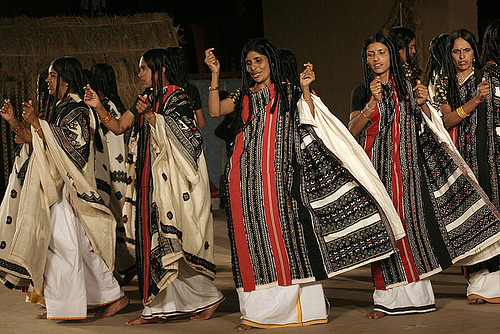
Toda dairies, buffaloes and dairymen are graded within a complex hierarchy according to relative sanctity, with different rules and rituals pertaining to each grade. The higher the grade of a dairy, the greater the sanctity of its buffalo herds and the dairyman-priest who operates it. And the more sacred a dairy, the more elaborate are the rituals that accompany the milking, churning and other daily activities of the dairyman-priest.
Apart from the "gods of the places", the Todas recognise another category of divine entities, the "gods of the mountains", because most of them are associated with one or another Nilgiri peak.

Unlike the "gods of the places", these are anthropomorphic deities, some of whom, the Todas say, once lived on earth as humans, or, better, as super-humans.
On was the son of Pithi. He created the buffaloes and the Todas in that order. In the Toda tradition we find instances where buffaloes are credited with almost human intelligence. Many of the Todas maintain that they worship the buffalo as a deity. On created 1600 buffaloes, behind the last buffalo came man, the first Toda.
On took one of the man’s ribs from the right side of his body and made a woman, the first Toda woman. On is now the ruler of the dead souls, after he went there to visit his son Puv and stayed back in his son’s company.
The Dualistic tradition of the Toda with regards to the Divine brother and sister of the mountains is interesting, in that the male is concerned with the spiritual aspects and the female with the Earthly nurtring, the buffalo cult suggests itself of similar importance as the bull was in the early Neolithic period in Anatolia

Pinarkurs was On’s wife. She created some buffaloes too. On’s buffaloes were the special ones that the Todas possess, the Nilgiri buffalo.
Pinarkurs’ buffaloes were ordinary. This must be a system devised by the Todas to distinguish their breed of long-horned buffaloes and exalt their
status. The Toda traditions do account for the creation of other buffaloes, but do not account for the creation of other humans. On created only the
Todas. The other human beings are unaccounted for.
In making a comparison then with Anatolian motifs of the Neolithic from places such as Catal Hoyuk and Hacilar i noted that there the bull was an important symbol of a tripartite belief system involving a symbolic colour scheme were Black indicated the Underworld, Red the intermediate realm of Earth, and White the Celestial, these of course the the colours of the Toda.
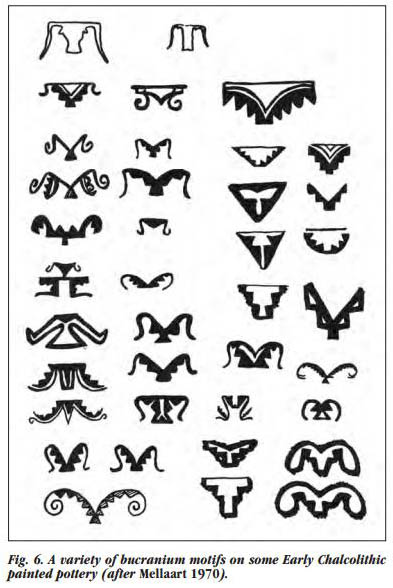
Teikirzi was On's sister. She became in charge of affairs after On left for the realm of the dead. By some accounts the magnificent breed of long horned buffaloes were created by this great female deity. It is possible that On was the creator, but after he left, Teikirzi was credited with creation in hymns of exaggerated praise. Teikirzi dwells everywhere. She defined the rules by which the Toda is to live by. She divided the Todas into 14 clans and gave the various Toda settlements their sacred names.
This was the sacred colour scheme of the Neolithic as seen in their artwork, and the generative power of the horned bull, symbol of first creation according to the Toda, would have been seen as a dynamic force proggresive through the levels.
The bull of Heaven did remain an important feature in religion even into the rise of civilizations such as Sumer and Egypt.
Looking at other Anatolian motifs one finds very direct comparison with those of the Toda in terms or the crosses and rosettes, and thus one needs to consider how this could have arisen.
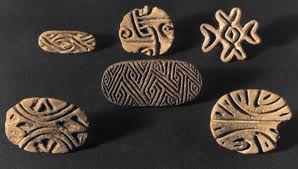
If the genetic evidence suggests a connection to Greek Cypriots that of course takes one close to Anatolia, and the first emigrations of the Neolithic were from the core region into the Eastern Mediterannean, but that doesn't begin to explain how part of that migration found it's way to India!
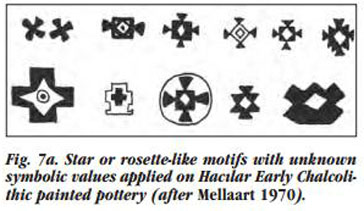
There was certainly the spread of Neolithic technologies and motifs into Dravidian regions such as Northern India and Iran at an early period, but that fails to explain how they arrived and survived in such pristine Anatolian form
So the Toda remain something of a mystery...
Toda Architecture
Star and flag for an interesting topic. I'm on my way to bed so I will definitely be back tomorrow to check this out in depth and to have a watch at those videos. Thanks for sharing.
Lots of ways
That seems unlikely, and the Toda themselves have no origin mythos other than having been created were they currently reside, and it fails to explain why their cultural motifs appears so closely related to Neolithic Anatolian!
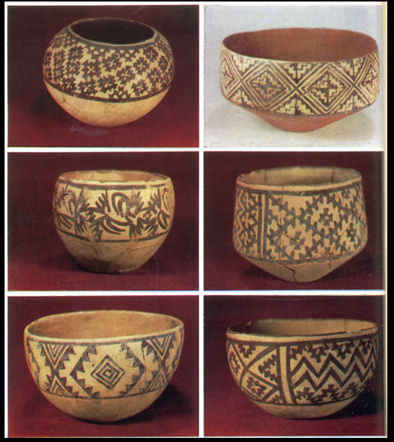
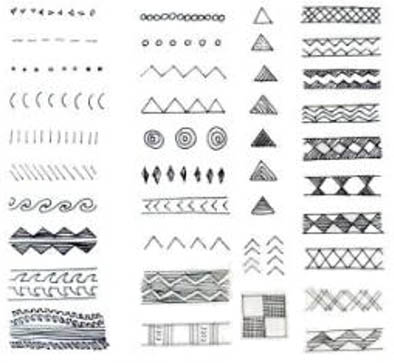
From Neolithic Anatolia to a remote region of Southern India with no stylistic variation...?
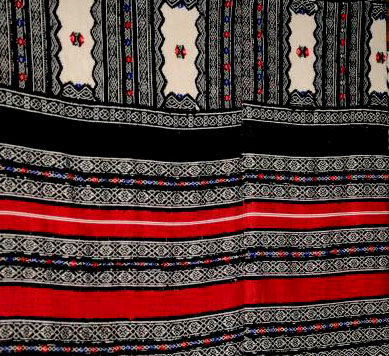
This is an interesting subject and since you have obviously done your homework on the topic, you must have an opinion as to how the Anatolia motifs found their way into the Toba culture in southern India. I'm most interested in your speculation....
My explanation would be a breeding programme during the Neolithic run by those super-human Deities
Neolithic Breeding Programme
Hmmm that's a large mouthful to swallow. Any thoughts on Michael Tellinger's research into the origins of humans in south Africa or is this outside your jurisdiction?
Very complex geometric patterns, bright dyes and vibrant.
Reminds me of Native American Indian styles.
Bull of Heaven?
Referring to a Lamassu or Cherubim or Sphinx creature??
en.wikipedia.org/wiki/Lamassu
en.wikipedia.org...
The winged Icons remind me of the
en.wikipedia.org/wiki/Faravahar
en.wikipedia.org...
or winged disc of Egypt
en.wikipedia.org/wiki/Winged_sun
en.wikipedia.org...
Not a Mysrtery at all.
Geometrical Porgression Art is common to many cultures, but sorry, not originating in any single place.
I am from kerala, South India.
I have been all over nigiris. met lots of toda people. even have toda friends.they are tribals. Not people rooted and planted from elsewhere.
Just that their creation myth is different?
Other than that, they appear to have invented the "Quonset hut" (Wikipedia Link). In which case, the US Navy Seabee's (Wikipedia Link) probably owe them some back-payments for patent infringement.
Also, their sacred herds have been subject to attack by tigers recently. Tigers are scarce, pushed to look for prey in populated regions due to the destruction of their habitat. Unlike their neighbors, however, the Toda abstain from hunting or harming the tigers.

It has often struck me that domestication is a two-way process: the animals we mold to our uses change us in turn. The Toda seem to have a strong grip on that fact, and to have embraced it to their advantage.
Lovely thread, Ms. K., as always.
The Sumerians did have the whole cattle and huts thing as well, and the curious fetish poles they placed on top can be sourced in origin to Anatolia, as well as the symbol for Inanna also being seen, they still make them in the marsh region of Southern Iraq.
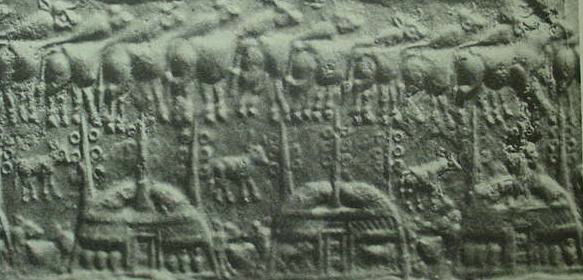
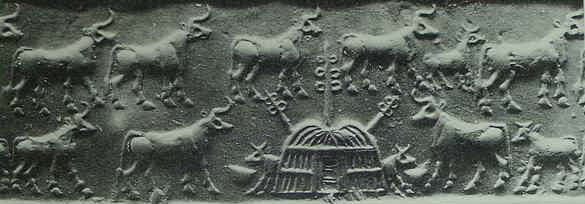
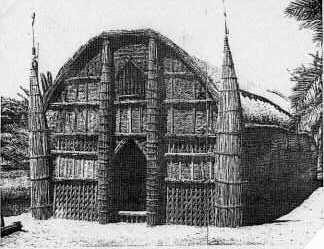
It was a religion that suited the cows well
reply to post by Eidolon23
They do seem to have a good relationship with their cattle that just seem to wander around the village as a member of the community, perhaps the cows sleep in the huts and the people outside, i'm not sure.
reply to post by coredrill
Well as i mentioned they insist that is their place of origin and i didn't take issue with that, but as for geometric tribal art all looking the same to you i'm afraid that just seems like ignorance to me, for example try finding an example from elsewhere of the cross seen in the first picture.
reply to post by pandersway
I think the cattle enclosure structures he concerns himself with are much more recent than his astronomy based datings suggest, and there is no associated cultural evidence or artifacts supporting his case, which just comes across as a commercial venture.
Yes your assumption would be in line with his newly formed political party----I was quite taken aback by that when I first read about his Ubuntu movement.
I am not surprised that you omit the fact that the Toda people, while vegetarians, practice the ritual sacrifice of the bulls that they (otherwise) venerate. They also practiced human sacrifice, of infant females, until fairly recently, according to 19th century sources cited by "Simon" (rumoured to be Peter Levenda, author of "Unholy Alliance," "Sinister Forces" and other interesting and well-crafted books). There are many reasons why these unsavoury facts might be concealed, some pedestrian, others more - sinister. It appears the mystery of the Toda remains a mystery...
do you have more pictures?
I know what fig.7 its a religious symbol you made some really good finds.. How come you searched this?
-
God's Righteousness is Greater than Our Wrath
Religion, Faith, And Theology: 3 hours ago -
Electrical tricks for saving money
Education and Media: 6 hours ago -
VP's Secret Service agent brawls with other agents at Andrews
Mainstream News: 7 hours ago -
Sunak spinning the sickness figures
Other Current Events: 8 hours ago -
Nearly 70% Of Americans Want Talks To End War In Ukraine
Political Issues: 8 hours ago -
Late Night with the Devil - a really good unusual modern horror film.
Movies: 10 hours ago -
Cats Used as Live Bait to Train Ferocious Pitbulls in Illegal NYC Dogfighting
Social Issues and Civil Unrest: 11 hours ago
-
VP's Secret Service agent brawls with other agents at Andrews
Mainstream News: 7 hours ago, 9 flags -
Cats Used as Live Bait to Train Ferocious Pitbulls in Illegal NYC Dogfighting
Social Issues and Civil Unrest: 11 hours ago, 8 flags -
Electrical tricks for saving money
Education and Media: 6 hours ago, 4 flags -
HORRIBLE !! Russian Soldier Drinking Own Urine To Survive In Battle
World War Three: 15 hours ago, 3 flags -
Nearly 70% Of Americans Want Talks To End War In Ukraine
Political Issues: 8 hours ago, 3 flags -
Sunak spinning the sickness figures
Other Current Events: 8 hours ago, 3 flags -
Late Night with the Devil - a really good unusual modern horror film.
Movies: 10 hours ago, 2 flags -
The Good News According to Jesus - Episode 1
Religion, Faith, And Theology: 13 hours ago, 1 flags -
God's Righteousness is Greater than Our Wrath
Religion, Faith, And Theology: 3 hours ago, 0 flags
-
Nearly 70% Of Americans Want Talks To End War In Ukraine
Political Issues • 13 • : Freeborn -
Mood Music Part VI
Music • 3101 • : ThatSmellsStrange -
VP's Secret Service agent brawls with other agents at Andrews
Mainstream News • 41 • : ThatSmellsStrange -
HORRIBLE !! Russian Soldier Drinking Own Urine To Survive In Battle
World War Three • 32 • : DaRAGE -
New whistleblower Jason Sands speaks on Twitter Spaces last night.
Aliens and UFOs • 55 • : baablacksheep1 -
Cats Used as Live Bait to Train Ferocious Pitbulls in Illegal NYC Dogfighting
Social Issues and Civil Unrest • 20 • : Asher47 -
Electrical tricks for saving money
Education and Media • 4 • : Lumenari -
DONALD J. TRUMP - 2024 Candidate for President - His Communications to Americans and the World.
2024 Elections • 514 • : WeMustCare -
The Acronym Game .. Pt.3
General Chit Chat • 7744 • : bally001 -
Truth Social goes public, be careful not to lose your money
Mainstream News • 128 • : Astyanax
